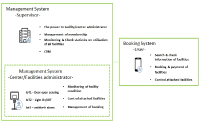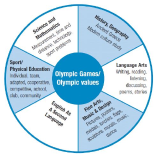
Purpose The purpose of this study was to examine students’ perceptions of girls’ participation in physical education(PE) in elementary schools and examine the impacts of a girl-friendly integrated program on children’s participation in PE classes. Methods The participants were 10 fifth graders (5 girls and 5 boys) and their teacher in an elementary school. Data which were collected from in-depth interviews with students, students’ journal entries, field observation, and teacher’s reflective journal entries were analyzed inductively. Results Findings revealed that boys perceived girls’ participation as passive, possessing a low level of skills, and staying at the peripheral position. Meanwhile girls expressed their desire to demonstrate their strengths in PE classes and were afraid of boys’ criticism regarding their lack of skills. There were also misconceptions and misunderstanding on girls’ PE participation between boys and girls. In order to resolve these issues, a girls-friendly integrative program was designed. based on the four guiding principles drawn from students’ perception: (1) from ignorance to interest, (2) from misunderstanding to understanding, (3) from sport skills to sport values, and (4) from competition to cooperation. The program integrated boys and girls for promoting active interaction and also integrated competence, knowledge, and dispositions to accommodate students’ various ways of PE participation. Findings revealed that the program had: (1) diversified students’ perceptions of PE participation, (2) promoted students’ diverse and active participation, and (3) established classroom atmosphere which emphasized positive values.



Purpose This study aims to suggest the application of IoT-based integrated management system to public sports facilities(PSF) in order to improve the utilization and management of PSF by analyzing the actual state of PSF empirically. Methods A survey was administered to managers(n=279) and users(n=500) of PSF in order to identify problems of current management and collect suggestions for improving the utilization and management of PSF. Previous research on establishing IoT-based system was also reviewed for considering the effectiveness of IoT technology. Results Generally, PSF are in low utilization and operate in a deficit. The deficit operation is caused by high labor costs and management expenses. The survey result shows that there are many problems in management and utilization such as lack of equipment, deteriorated facilities, shortage of manpower and funding, limited programs, difficulties in promotion. The result also shows that PSF need to consider developing local demand-based programs, reducing management costs, extending opening hours, improving online booking system. Conclusion To solve the problems of PSF in utilization and management, this study suggests that IoT-based integrated management system needs to be applied to PSF. It is expected that applying IoT-based integrated management system to PSF would improve operational effectiveness, ease of facility management, and user convenience.



PURPOSE This study aimed to develop a positive psychological intervention program for a college ice hockey team and test its effects based on application to the team. METHODS The demands of 78 college ice hockey players were asked through open questionnaires. Collected results underwent integrated analysis to develop the desired program through the participants who were also observers of the team. The objectives of the program were established, and an appropriate program was developed based on the analyzed data, expert opinion, and precedent research. The developed program was applied to 26 players of a college ice hockey team to verify its effects. Tasks included writing experience reports and in-depth interviews. The Happiness Measures 1, Strength Knowledge, and Team Interaction Questionnaires were also administered. Collected qualitative data were categorized to follow inductive analysis procedures, while paired t-tests were performed for quantitative data using SPSS 25.0. RESULTS To improve the application of the program in real situations and maintain credibility and validity, the program was developed based on analyses of individual and team demands, methods of the participant as an observer, expert opinion, and other considerations. Statistically meaningful differences in positive psychological mind, happiness, recognition and utilization of strengths, team interactions, team cohesion, and so on were found using paired t-tests comparing data before and after the developed positive psychological intervention program. CONCLUSIONS Providing opportunities to recognize individual and team strengths and have valuable experiences for each player could enhance interactions between teammates and create a favorable team environment.
PURPOSE This study aimed to apply a capacity building program to sport life skill leaders and to provide cases of this process. METHODS The study participants included four leaders (male=2, female= 2, Mage=37.5) who were managing a sport life skills program at a university. They participated in a capacity building program, which consisted of (a) understanding (leader seminar), (b) application (managing the sport life skills program), and (c) evaluation (leader’s self-reflection), which were conducted in eight sessions. Four leaders conducted self-evaluations using program quality assessment (PQA) during every session, and quantitative and qualitative data were collected. Qualitative data were derived using a cross-case analysis, and quantitative data were used for calculating the effect size after performing the paired t-test. RESULTS Analyzing the reported cases of sport life skill leaders, the use value of the capacity building program was identified. Furthermore, the cases reported by the four leaders enabled observation of how the leader’s capabilities were strengthened. In the paired t-test, the effect size of physical and psychological safety, appropriate structure, supportive relationship, opportunities to belong, support for efficacy mattering, opportunities for life skill building, excluding integration of family, school, and community effort, were all significant. All effect sizes were found to have “very large effects.” CONCLUSIONS The capacity building program played a positive role in strengthening the leaders’ life skill coaching capabilities. These findings have practical implications—chiefly, it is important to strengthen leaders’ or coaches’ capabilities in order to foster life skill development and transfer of student-athletes.

[Purpose] This study aims to examine necessity and characteristics of the K-OVEP, and discuss ways of settle and spread the program stably through cases applied in school settings. [Methods] To do so, educational components and curriculum of the K-OVEP was represented by analyzing references, developmental materials, and program application. This study was examined through the application process and observation of long-term program of the K-OVEP from two types of educational fields, 2 elementary schools and 2 middle schools. In order to examine if the K-OVEP achieves the aim of the IOC and the K-OVEP, basic level study was conducted to 187 students who participated in the program in 2016. The questionnaire consisted of three categories; ‘cognition part’ through the Olympic games and the Olympic values, ‘value part’ regarding five educational themes of the OVEP, and ‘interest part’ asking interest and involvement in sports activities, participants answered the questionnaire before and after the education. [Results] We found that K-OVEP is an integrated value based educational program regarding Olympics, stresses personality education, encourages students to explore their career, and is a process oriented education. The results showed that the K-OVEP achieved the educational goals in every categories and questions, and educational effects in sports activity looked different among schools and the environments. [Conclusion] This study was performed to participants at first year of the introduction of the K-OVEP, so in order to keep track of learners’ significant change continuously, expansion of participants, steady development of various new programs, development of assessment tools, experts training and follow-up studies will be required.


PURPOSE This study analyzed research on physical activities for elementary school students 1st and 2nd-graders to explore teachers’ perceptions and instructional practices in physical activity classes. METHODS Twelve studies published in academic journals conducted between 2000 to 2022 were selected for analysis. RESULTS The research articles were categorized into three domains: perception of physical activity in lower grades, operational features, and factors influencing practices from a didactic perspective. Challenges identified include dilemmas between curriculum documents and actual practice, a lack of practical teaching expertise, and a teaching culture discouraging physical activity in lower grades. Operational patterns were restructured into “avoidance-style classes,” “ad-hoc classes,” “textbook-dependent classes,” and “textbook-reorganization classes.” Factors influencing physical education for early elementary students included “teacher support factors,” “environmental factors,” and “administrative factors.” CONCLUSIONS In conclusion, this study advocates for policies that systematically improve perception, administration, and support classes for activating physical activities in lower elementary school students. The findings suggest the need for strategies such as adapting integrated curricula, creating training programs and educational materials, ongoing professional development activities for teachers, and specific research focused on physical activities for lower grade elementary students.